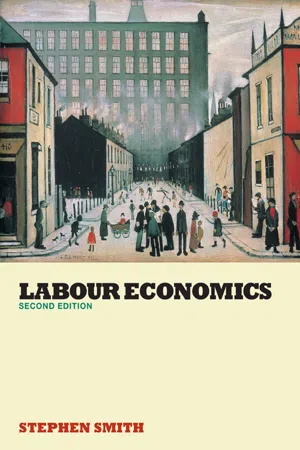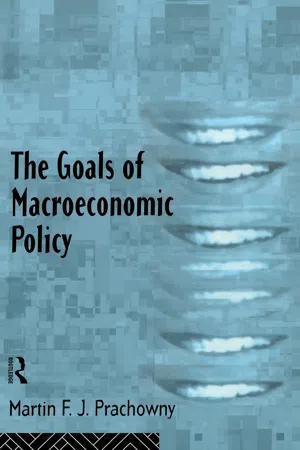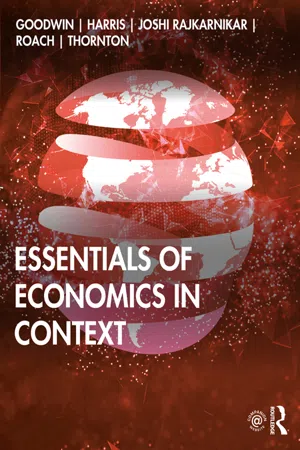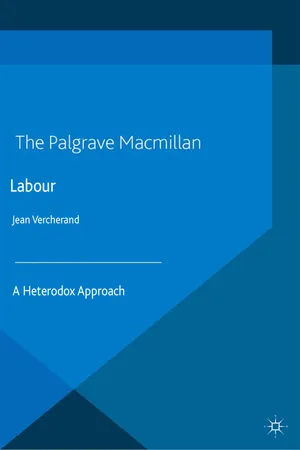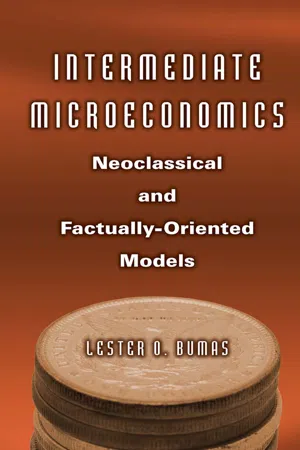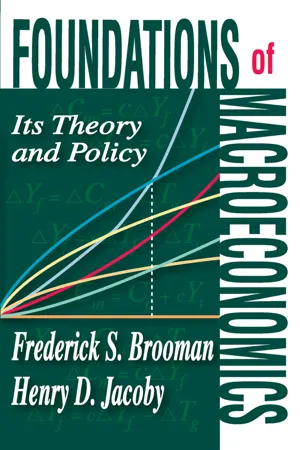Economics
Labor Supply Curve
The labor supply curve illustrates the relationship between the wage rate and the quantity of labor supplied by individuals in a given market. It typically slopes upward, indicating that as the wage rate increases, individuals are willing to supply more labor. This reflects the basic economic principle that higher wages incentivize individuals to work more.
Written by Perlego with AI-assistance
Related key terms
10 Key excerpts on "Labor Supply Curve"
- eBook - ePub
- John Smithin(Author)
- 2008(Publication Date)
- Routledge(Publisher)
A convenient term for this sort of construct would be a “wage curve” (as opposed to a “Labor Supply Curve”), and, in fact, Blanchflower and Oswald (1994), for example, have already introduced this terminology, in estimating what they call a “wage curve” – in their case a relationship between wages and unemployment – for the UK 1973–90. While recognizing that those authors have argued that their own statistical work is consistent with models based on the usual sort of optimization procedures, 2 we will appropriate the same term here for any relationship that purports to determine the aggregate real wage rate as the dependent variable, rather than the supply of labor itself, including those relationships based mainly on macroeconomic and institutional factors. As one example, in the context of the static labor demand/supply type diagrams that we have been dealing with above, perhaps it could be argued there is an upward sloping wage curve existing inside the choice-theoretic Labor Supply Curve, as is shown in Figure 7.6 for example. This wage curve still slopes upward, and this might be on the argument, for example, that in the overall macroeconomic or socioeconomic context, an increase in the overall level of employment, implying reductions in unemployment, will tend to increase the bargaining power of labor (e.g. by strengthening the unions, or just making employers less resistant to increasing wages), and hence real wages - eBook - ePub
- Stephen W. Smith(Author)
- 2003(Publication Date)
- Routledge(Publisher)
The supply of labour can be analysed at two levels: the microeconomic level, concerned with individual and household labour supply, and the macroeconomic or aggregate economy level. The following account of the economic analysis of labour supply begins with a microeconomic theory based upon the neoclassical solution to the consumers’ allocation problem.The analysis constructs a simple model of an individual’s labour supply decision. Basically it involves a choice between work and leisure, subject to a budget or income constraint. We are not concerned with any particular individual, instead we are dealing with an ‘idealised’ microeconomic individual who seeks rationally to maximise his/her utility.Utility is the benefit or satisfaction an individual presumably derives from the activity of consuming goods/services. Work is assumed to confer a certain amount of disutility. Wages help to offset that negative aspect and enable the individual to generate income, which can be used to consume goods and services in future time periods. Without resorting to excessive detail, the main results of the microeconomic analysis of labour supply can be simply reproduced. On the basis of the simplifying assumption that individuals are free to determine the hours they wish to work, Figure 1.1 shows the relationship between work and pay. Obviously in choosing how much labour to supply (hours worked, H), the individual is simultaneously determining leisure time (L). Hence labour supply and the demand for leisure are being decided jointly, with the opportunity cost of leisure being the wage earnings forgone by not working. Leisure is assumed to be a normal good, which features in the rational individual’s utility function. Hm is an imposed maximum duration of the working day.1 Wages bring utility through the consumption of goods, services and leisure. Work brings disutility.2Figure 1.1Figure 1.2The curves I1 , I2 and I3 - eBook - ePub
- Peter Sloane, Paul Latreille, Nigel O'Leary(Authors)
- 2013(Publication Date)
- Routledge(Publisher)
Chapter 2 The Labour Supply CurveIntroductionLearning OutcomesAt the end of this chapter, readers should have an understanding of:- The multi-dimensional nature of labour supply;
- The distinction between income and substitution effects and how a backward-sloping labour supply curve is possible;
- How family income, taxes and overtime result in non-linearities in the labour supply function;
- The effect of the standard work-week on supply choices of individual workers;
- Why employers might prefer to have lower standard wage rates and higher overtime wage premium payments;
- What determines the incidence of part-time work, overtime working, absence rates and double-jobbing.
We have already examined the decision whether or not to be a member of the labour force in Chapter 1 , which focused on labour force participation, while the investment decision over whether to increase the qualifications and skills possessed by the individual is considered in Chapter 3 . In this chapter, we focus more on the supply of hours and the constraints facing workers in optimising their combination of earnings and hours in particular jobs.Labour supply is complicated by the fact that it is multi-dimensional. Effective supply may be varied by changes in the number of workers, changes in the number of hours worked by a given labour force, and changes in the intensity of work, which may be influenced, among other things, by the input of effort from the worker. Thus, not only are workers themselves heterogeneous, but also units of labour input offered by the same workers may vary over time as the nature of work or incentives alter, or through physiological factors such as settling in or fatigue. The theory of labour force participation has dealt with the binary choice of whether to work in the labour market or not, so that here we are predominantly concerned with the intensity with which workers offer their services in terms of duration, the level of commitment being the concern of Chapter 10 - eBook - ePub
- Martin Prachowny(Author)
- 2012(Publication Date)
- Routledge(Publisher)
hours, positions on the labor-supply curve are superior in a welfare sense to those positions off the curve. To the left of the supply curve at any given real wage, there are a number of people who want to work but are not employed and are therefore involuntarily unemployed. On the other hand, a position to the right of the supply curve would require involuntary exchange.- The supply of labor is composed of heterogeneous individuals, even though the participation decision has been derived from a utility-maximizing “representative agent”. Remembering that the supply curve is generated by having more and more people pass their reservation wage, those with very low reservation wages and early entry into the labor market enjoy rents at any wage above their reservation wage. These people earn rents because their welfare rises with the real wage but without any adjustment of their behavior. Hence, it is possible to order sequentially all individuals in the labor market by the amount of rent they receive from employment; those with the lowest reservation wage receive the largest rents.
3.2 The Demand for LaborWhile supply decisions in the labor market are made by individual worker-consumers, demand decisions are made by firms and their management. The major choice made by a productive enterprise is the input-output relationship: given a certain goal for output over a specific time frame, what factors of production should the firm use and how much of each? The ultimate aim of the firm is to maximize its profits, which represents the difference between its revenue generated by sales of output and costs dictated by payments to its factors of production.3.2.1Profit-maximizing Choices for a Firm's InputsThis maximization process can be written as:where II are profits in real terms (i.e., adjusted for price changes), Y( ) is the production function for output, a composite commodity for the entire economy, NH stands for the total hours worked by the firm's labor force and K represents the capital stock used in the production process. Consistent with the assumption made in the discussion of labor supply, each person works H hours per day for W/P per hour in real terms or H W/P per day. Capital, on the other hand, is a stock of equipment and structures such as machinery, warehouses and computers, available to the firm, for which it pays a user cost per unit of time, R/P, as if it were leasing its capital from a firm specializing in this function. Some of the properties of the production function are: (a) marginal products of each factor are positive, (b) marginal products decline as more of the factor is used, and (c) marginal products increase when more of the co-operating factor is available, - eBook - ePub
Modern Labor Economics
Theory and Public Policy (International Student Edition)
- Ronald G. Ehrenberg, Robert S. Smith(Authors)
- 2017(Publication Date)
- Routledge(Publisher)
same. Thus, the choice would have to be made on the basis of compensation alone. If a firm were to lower its wage offers below those of other firms, it would lose all its applicants. The horizontal supply curve is, therefore, a reflection of supply decisions made among alternatives that are perfect substitutes for each other.We have argued that firms wishing to hire paralegals must pay the going wage or lose all applicants. While this may seem unrealistic, it is not a bad proposition with which to start our analysis. If a firm offers jobs comparable to those offered by other firms but at a lower level of pay, it might be able to attract a few applicants of the quality it desires because a few people will be unaware of compensation elsewhere. Over time, however, knowledge of the firm’s poor pay would become more widespread, and the firm would have to rely solely on less-qualified people to fill its jobs. It could secure quality employees at below-average pay only if it offered noncomparable jobs (more pleasant working conditions, longer paid vacations, and so forth). This factor in labor supply will be discussed in chapter 8 . For now, we will assume that individual firms, like individual workers, are wage takers ; that is, the wages they pay to their workers must be pretty close to the going wage if they face competition in the labor market. Neither individual workers nor firms can set a wage much different from the going wage and still hope to transact. (Exceptions to this elementary proposition will be analyzed in chapter 5 .)The Determination of the Wage
The wage that prevails in a particular labor market is heavily influenced by labor supply and demand, regardless of whether the market involves a labor union or other nonmarket forces. In this section, we analyze how the interplay of supply and demand in the labor market affects wages.The Market-Clearing Wage Recall that the market demand curve indicates how many workers employers would want at each wage rate, holding capital prices and the product demand schedule constant. The market supply curve indicates how many workers would enter the market at each wage level, holding the wages in other occupations constant. These curves can be placed on the same graph to reveal some interesting information, as shown in Figure 2.12 - eBook - ePub
- Neva Goodwin, Jonathan M. Harris, Pratistha Joshi Rajkarnikar, Brian Roach, Tim B. Thornton(Authors)
- 2020(Publication Date)
- Routledge(Publisher)
Chapter 3 . This is true for the individual firm’s demand for labor, as well as for the market demand curve for labor, made up of the horizontal sum of the demand curves of individual firms. The reason for the downward slope is that when wages are high employers have incentives to economize on the use of labor. They may cut back on production or try to substitute other inputs (e.g., machinery or computerization) for the type of labor whose wage is high. But when wages are low employers may be able to expand production or substitute relatively cheap labor for other inputs. In terms of the marginal revenue product logic discussed previously, we can say that firms are willing to accept a lower marginal revenue product of labor when wages are low but will insist on a high marginal revenue product when wages are high.Labor demand will tend to be relatively wage elastic if there are good substitute inputs available and if the wage bill is a large proportion of total production costs (so that the employers are motivated to seek out substitutes). Labor demand will tend to be relatively inelastic if no good substitute inputs are available and the wage bill is a small proportion of total costs. A 2015 meta-analysis based on over 100 studies from all regions of the world finds that labor demand tends to be inelastic, averaging around 0.20 in the short run and 0.40 in the long run.6 We would expect labor demand to be more elastic in the long run as employers have more time to find substitutes for relatively expensive labor. The article also found that demand is more elastic for low-skilled workers, as it is easier to find substitutes for workers without specialized skills.The labor demand curve may shift if there is a change in the demand for the good or service that it is used to produce, if technological developments alter the production process, if the number of employers changes, or if the price or availability of other inputs changes. For example, when an organization experiences a fall in demand for its products, its labor demand curve will shift back as well. - eBook - ePub
Work Behavior of the World's Poor
Theory, Evidence and Policy
- Mohammed Sharif(Author)
- 2018(Publication Date)
- Routledge(Publisher)
6 and their labor supply behavior can obviously not be analyzed by the existing upward sloping supply theory. Not only does this exclude from labor supply analysis a significant segment of the world’s working population, but it also forces empirical researchers to look for unusual explanations when they observe something that differs from the upward sloping supply pattern. Moreover, the perverse-behavior analysis of the labor supply of a large portion of the world’s working population might have serious adverse implications for human resource and economic development policies in general and poverty-alleviation policy in particular.The conventional analytical assumption about the reservation wage7 is the second misconception that accounts for the failure to accept the negative supply behavior of the poor as rational. In this framework, the concept of a reservation wage relates to the lowest point of the upward sloping supply curve. Implicit in this is the assumption that, at the reservation wage rate, the worker earns/receives at least a subsistence income from non-labor sources (asset or transfer income, past savings, etc.), which affords him/her the ability to quit working if the wage rate falls below that reservation level. Thus again, the possibility of below-subsistence living and that of below-subsistence labor supply are ruled out.However, if non-labor income is not available—which is really the case for poor workers, especially in traditional economies—the notion of a reservation wage establishing a threshold to the non-decreasing supply function is irrelevant. In such a situation, the lower limit to the non-decreasing segment of the supply curve will be given by the wage-labor combination that yields the worker’s subsistence income. This wage-labor combination will, in turn, depend on the socially determined standard of hours/days of work and the wage rate that yields the subsistence income at that standard hours/days. While this wage rate can be called a subsistence wage, it is far from being a reservation wage, because a reduction in the wage rate below that level would require the worker to increase his/her hours/days of work, rather than to quit work or even to work less. The possibility of increased labor supply at lower wages derives from the worker’s need to maintain a subsistence income, which graphically translates into a forward falling (i.e. downward sloping) segment in his/her supply curve (Myint, 1971)—with the income effect of a wage change dominating the substitution effect on this segment. This forward falling supply curve reflects distress sale of labor and is analyzed as rational behavior using the conventional utility maximizing hypothesis (Barzel and McDonald, 1973; McGregor, 1990; Sharif, 1991a). - eBook - ePub
Labour
A Heterodox Approach
- Jean Vercherand(Author)
- 2014(Publication Date)
- Palgrave Macmillan(Publisher)
Its shape is a priori indeterminate as two conflicting phenomena are involved. Indeed, an increase in the wage rate results in making leisure time more “costly”: the wage foregone by not working – thus by taking leisure time – increases. Also, when the price of a good rises, the quantities demanded fall, all other things being equal. This is what is called the “substitution effect”. However, things do not stay equal, since increasing the wage rate leads to higher income, which permits “purchasing” more leisure time – the “income effect”. A priori, it is not possible to know which of these two effects wins against the other and thus what the global result will be. It depends on the shape of the indifference curves, meaning the preferences of each household.Figure 2.4 The determination of the individual labour supply curveNonetheless, on the basis of experimental studies, many economists consider that this individual labour supply curve increases up to a certain point: the volume of labour increases with its rate of remuneration, then decreases after reaching a given level. Although it fails to provide absolute certainty, the advantage of this curve is that it more or less represents labour supply as being like any other supply of goods.The shape of this individual labour supply curve has been the subject of debate through history and still remains controversial. Whatever the case, we shall leave this question since a radically different point of view will be defended further on (Ch. 3 - eBook - ePub
Intermediate Microeconomics
Neoclassical and Factually-oriented Models
- Lester O. Bumas(Author)
- 2015(Publication Date)
- Routledge(Publisher)
Figure 12.8 .It is usually assumed that at relatively low wage rates an increase in the wage rate brings about an increase in the quantity of labor hours supplied and that at relatively high wage rates an increase in the wage rate leads to a decrease in the number of hours supplied. This means that the substitution effect is stronger than the income effect at low wages. Then for a substantial range of higher wages the quantity supplied is roughly constant implying the offsetting of the substitution effect by the income effect. Finally, supply becomes “backward bending” implying that the income effect is greater than the substitution effect at relatively high wage rates.Figure 12.9. The Competitive Labor Market and the Supply to the FirmWhy would a person have almost the same propensity to work when wages were quite low as when they are higher? A number of reasons are suggested: (1) It may be a question of work or starve. (2) There is a social imperative that males work after schooling and before being aged. The somewhat weaker social imperative holds for unmarried women without children. For those with children there is some expectation that they will enter the labor market once the children can fend for themselves. (3) Many work because there are those who depend on them. (4) Finally, many of us are imbued with a work ethic.The Supply to Firms, Occupations, Industries, and Regions
Workers in supplying their services to the economy have only one alternative to work, not to work. But there are many alternatives when decisions involve supplying labor services to one among many firms, occupations, industries, or regions. As the number of alternatives increase, the supply becomes more elastic. Why should the individual work for a firm which pays less than “the going rate” if jobs at or above that rate are available? - eBook - ePub
Foundations of Macroeconomics
Its Theory and Policy
- Frederick S. Brooman(Author)
- 2017(Publication Date)
- Routledge(Publisher)
To the extent that firms try to increase output to meet increased real demand (since even at full employment an individual firm can increase output by drawing resources away from others), their attempts to hire more labor for the purpose will create an excess of demand over supply in the labor market, and this will cause the money wage w to rise. Alternatively, if firms’ initial reaction to the rise in real demand is to raise prices rather than output, the consequent fall in real wages may cause the supply of labor to fall 13 below the level needed to sustain the current level of output, so that money wages must be increased to restore real wages to their original level. In addition, labor unions can be expected to react to the rise in prices by insisting on compensating increases in money wages to maintain their members’ living standards. Since the supply curve s (Q, w̄) shows the money value of each level of output (Q) when it is multiplied by its supply price w̄ /MPL, the rise in w will now increase the value of s associated with each level of Q ; the curve s (Q, w̄) will therefore move vertically upward in proportion to the increase in w, continuing to move as long as w goes on rising. With money wages and prices rising at the same rate, there will be no reduction in real wages and therefore no redistribution effect to restrain the upward movement of the aggregate demand curve. Both curves will be shifting upward simultaneously, as shown in Figure 10.4. It will be recalled that when the demand curve d (Q, p) was introduced (p. 239), it was defined for a particular fixed level of the money wage rate w̄), as was the supply curve. As the money wage rate rises, however, the supply curve shifts upward, and the “supply price” associated with each level of output increases. But this same “supply price” enters the functional relationship for demand – i.e., the p in d(Q, p) – and therefore the demand curve must be redrawn for each change in w
Index pages curate the most relevant extracts from our library of academic textbooks. They’ve been created using an in-house natural language model (NLM), each adding context and meaning to key research topics.

